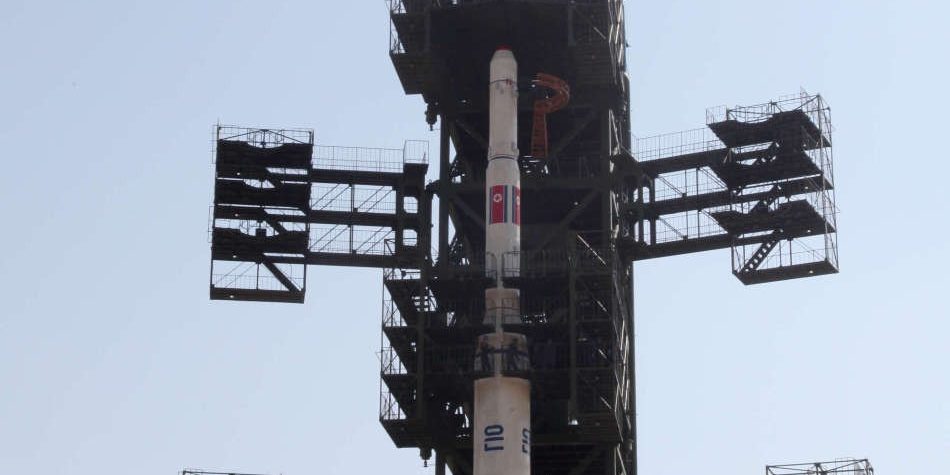Facts
| North Korean/U.S. Designation | Taepodong-2/Unha-3/Moksong 2/Paektusan 2/Pekdosan 2 |
| Missile Variants | Unha/Nodong |
| Mobility and Role | Launch Pad/surface-to-surface intercontinental ballistic missile |
| Designer/Producer | North Korea/China/Russia |
| Range | 5,500-10,000km |
| Warhead Type and Weight | Conventional or Nuclear/700-1,000kg |
| MIRV and Yield | No MIRV capability / N/A |
| Guidance System/Accuracy | Inertial/2-4km CEP |
| Stages/Propellant | Three-stage/Liquid |
| IOC | 2006 |
| Status/Number of Units | N/A |
Development
The Taepodong-2 is suspected of being North Korea’s first Intercontinental Ballistic Missile (ICBM). [1] The Taepodong-2 is a multi-stage rocket with a liquid propellant. It is a militarized version of the civilian Unha-3 satellite launch vehicle. It is believed to have a range of at least 5,500 Km. [2]The Taepodong-2 has an estimated payload from 700-1,000 Kg. [3] This missile still requires a conventional launch pad, and preparations for its launch are highly visible, taking multiple days to be readied.
The creation of the multi-stage rocket was a decidedly international effort. In the late 1980s and early 1990s, there were reports of Chinese and Russian engineers helping North Korea reverse engineer Chinese and Russian missiles to create indigenous prototypes. [4] Some reports place the beginning of development of the Taepodong-2 in 1987 as North Korea focused on producing long range ballistic missiles. The 1998 Rumsfeld report concluded there was evidence that North Korea had developed infrastructure to launch the Taepodong-2. [5] There were rumors of launch pad testing in the early 2000s but the first publicly recognized test launch was in 2006 resulting in a first-stage failure. The second attempt was in 2009 resulting in a third-stage failure. Finally, a third attempt was launched in April 2012 but failed somewhere in the first or second stages. Under the pseudonym of Unha-3, in December 2012 the Taepoddong-2 launched without malfunction and nominally placed a satellite into orbit, which later entered an unrecoverable tumble. The fifth test of the rocket was on Feburary 7, 2016, when it was used to place a satellite into orbit, which succeded. It is unknown how many of these missiles exist. [6]
Strategic Implication
The range on the Taepodong-2 would allow North Korea to strike Japan, Guam, Hawaii, and possibly Alaska and the continental United States. In South Asia and Oceania, North Korea would also have the capability to strike at India or Australia. [7]This weapons system shows the ambition of the North Korean missile program. According to the Department of Defense, North Korea “reaffirm[s] its need to counter perceived U.S. “hostility” with nuclear-armed ICBMs.” [8] Despite the failed test launches, each successive test showed an increasing capability by North Korea to develop ICBM technology.
Missile Tests
Click here to see a list of the Taepodong-2 tests.
References
[1] “Taep’o-Dong 2 (Td-2),” Federation of American Scientists, accessed June 12, 2014,http://www.fas.org/nuke/guide/dprk/missile/td-2.htm.
[2] Ballistic and Cruise Missile Threat,” Air Force ISR Agency, 2013, accessed June 12, 2014,http://www.afisr.af.mil/news/story.asp?id=123355694.
[3] “Taep’o-Dong 2 (Td-2),” Federation of American Scientists, accessed June 12, 2014,http://www.fas.org/nuke/guide/dprk/missile/td-2.htm
[4] Daniel Pinkston, “The North Korean Ballistic Missile Program,” Strategic Studies Institute, accessed June 12, 2014,http://www.strategicstudiesinstitute.army.mil/pdffiles/pub842.pdf.
[5] Taep’o-Dong 2 (Td-2),” Federation of American Scientists, accessed June 12, 2014,http://www.fas.org/nuke/guide/dprk/missile/td-2.htm.
[6] Markus Schiller, “Characterizing the North Korean Nuclear Missile Threat,” 2012, accessed June 12, 2014,http://www.rand.org/content/dam/rand/pubs/technical_reports/2012/RAND_TR1268.pdf
[7] Daniel Pinkston, “The North Korean Ballistic Missile Program,” Strategic Studies Institute, accessed June 12, 2014,http://www.strategicstudiesinstitute.army.mil/pdffiles/pub842.pdf.
[8] “Military and Security Developments Involving the Democratic People’s Republic Of,” Department of Defense, accessed June 12, 2014,http://www.defense.gov/pubs/Report_to_Congress_on_Military_and_Security_Developments_Involving_the_DPRK.pdf

